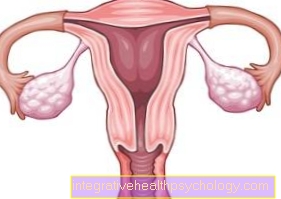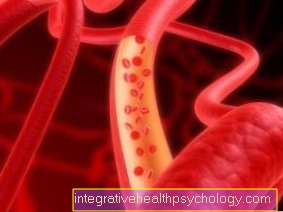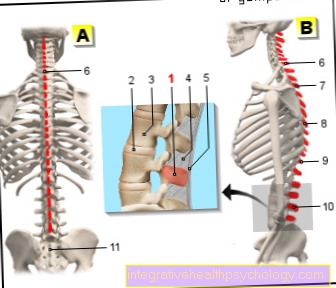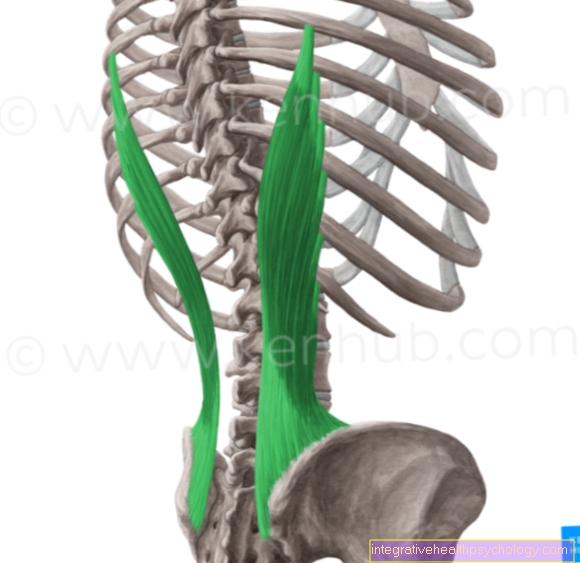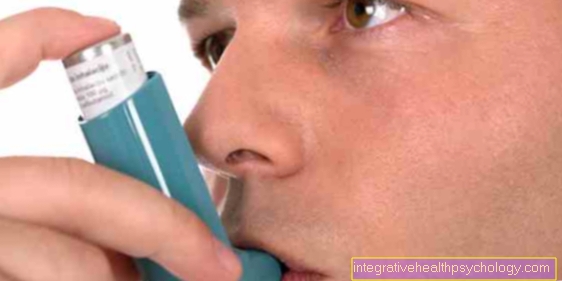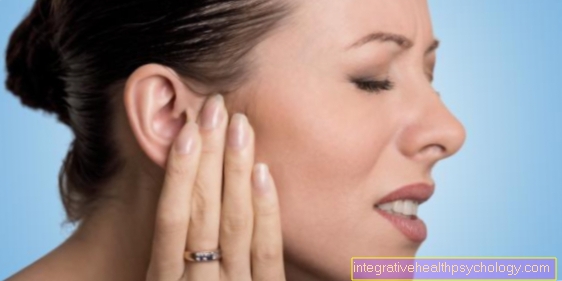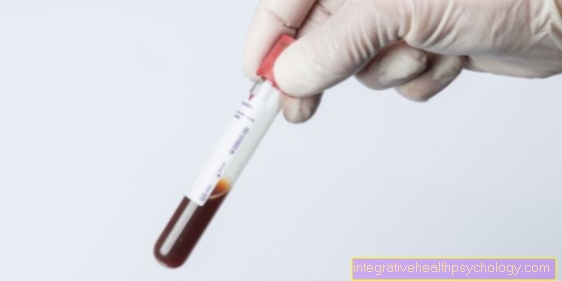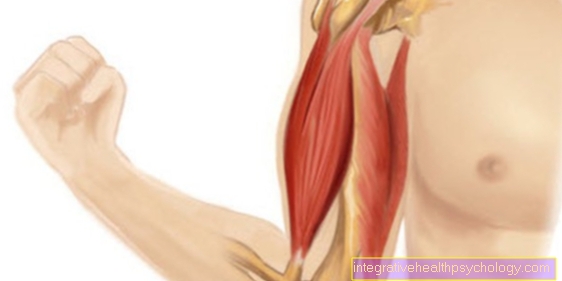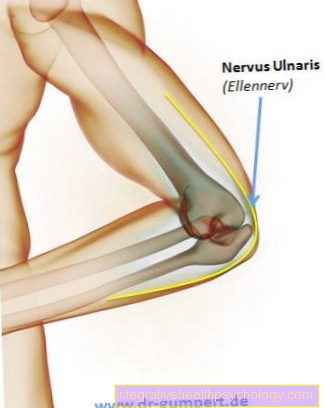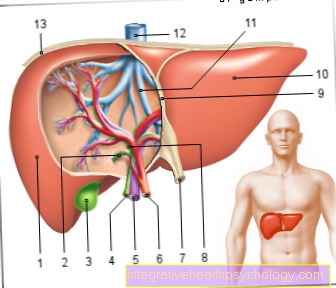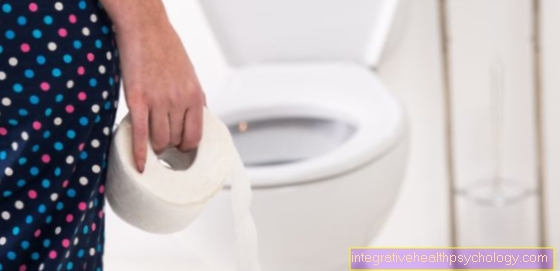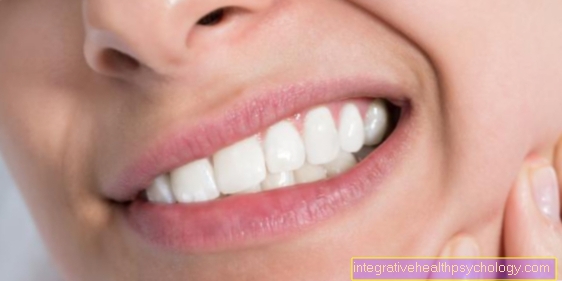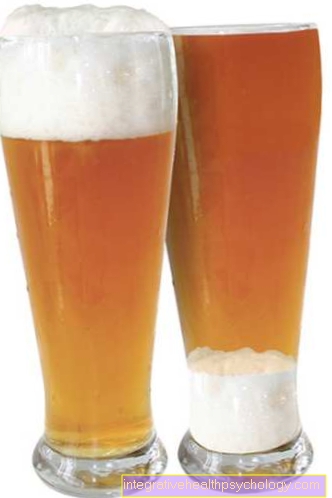Triptans
definition
Triptans are a specific group of drugs that are used in the treatment of headaches, especially against migraines. Unlike other pain relievers, the triptans are not necessarily effective for normal headache. Migraine headaches and so-called cluster headaches in particular can be successfully treated with triptans. The reason is the very special mechanism of action, which is different with triptans than with other painkillers.
You can find more information on these topics here: Migraines and Cluster headache

Effect of the triptans
After ingestion, triptans bind to special receptors called 5-HT. There are still two subgroups of the receptors that are stimulated by the docking of the triptans. The 5-HT receptors are normally intended for serotonin, which docks there in the normal metabolism and leads to corresponding effects in the body. It is assumed that the blood vessels of the meninges begin to widen during a migraine attack, and for this reason the throbbing pain that is typical of migraines is triggered. By docking a triptane to a serotonin receptor, the blood vessels begin to contract again, which leads to a relatively rapid improvement in symptoms.
Another mechanism of action of the triptans is seen in the inhibition of the release of inflammatory substances, which is triggered by the body during a migraine attack. As a result of this inhibition, there is little or no spread of the inflammatory reaction in the body. The third mechanism of action is the general inhibition of pain transmission via the cerebral cortex. All three mechanisms of action together ensure that the development of the migraine headache and the cluster headache is restricted very quickly and that headaches cannot occur at all to the extent feared. Triptans are not taken preventively to prevent migraine and cluster headaches but may only be taken when the migraine headache has set in.
For more information on the mechanism of action, see Serotonin.
Indications of the triptans
Triptans have been prescribed more frequently in the last 10-15 years. They are mainly used in the treatment of migraines and cluster headaches. For migraines, triptans can be used for migraines that accompany aura or for migraines without aura. Triptans are usually to be taken individually and do not require combination treatment with other medications. In some exceptional cases, a combination with paracetamol or ibuprofen can be considered if the effect of the triptane is insufficient and you want to avoid a rapid increase in the dose of this drug.
Triptans for migraines
Migraines are the main areas in which triptans are used. It should not be taken preventively, but only when the first signs of a migraine become noticeable. The migraine is classified by the fact that there is usually unilateral pain that spreads behind the eye. The pain is almost always throbbing and pounding and is often pulse-synchronized. As a rule, and depending on the severity of the migraine attack, moderate to severe accompanying symptoms can also occur. These include nausea and vomiting, weakness, malaise, and visual disturbances. Very common and characteristic of a migraine headache is also the sensitivity to light, which those affected usually spend the day in a completely darkened room.
There are forms of migraine that are associated with a so-called aura. An aura is understood to mean neurological complaints such as visual disturbances, abnormal sensations or other neurological deficits that typically occur before a migraine attack. In this case, those affected notice several minutes in advance that a migraine attack is approaching. Visual disturbances before a migraine attack are classically pronounced. The visual field of an eye is severely restricted by small flashes that rotate very quickly in a kalleidoscope-like manner. The restriction of the field of view can take a few minutes to an hour. Shortly afterwards, the often very severe mirage-like headaches begin while the visual disturbances recede. Of all known types of headache, migraine, along with tension headache, is the most common form. A genetic component is suspected in the development of migraines.
Hormonal connections are also held responsible for the development of migraines. Women are more likely to suffer from migraines than men and young patients before menopause more often than after menopause. Many patients state that the frequency of migraines has decreased after menopause or that migraines have completely disappeared. Sometimes a connection is seen between migraines and the consumption of certain foods.
You may also be interested in the following topics: therapy for migraines, homeopathy for migraines
Dosage via triptans
The dosage of triptans depends on the drug used. Sumatriptan, which is used very often, should be taken once as a tablet at a dose of 50 mg. If the symptoms recur or do not go away completely, another tablet can be taken 4 hours after the first dose. A maximum of 100 mg should be taken per day. Other forms of administration of sumatriptan are available as nasal sprays and also as injections. The effect is similar for all dosage forms. Zolmitriptan is available in doses of 2.5 mg or 5 mg. This drug is also approved as a very fast acting nasal spray in a dosage of 5 mg. Rizatriptan is available in doses of 5 mg and 10 mg tablets.
Side effects of triptans
Triptans are generally well tolerated. As with all drugs, there are side effects with triptans that need to be considered and which must be weighed against the benefits of the drug. Feeling weak and / or dizzy are often reported after taking a triptane for a long time. The vertigo can sometimes be described as fluctuating or rotating, sometimes a mixed picture is described. The dizziness can occur at rest, but also especially after changing position (from sitting to standing, etc.). Depending on the severity of the vertigo and the necessity of the use of medication, consideration should be given to stopping the triptan and replacing it with another pain reliever.
Other neurological complaints that have been reported with the medication of a triptane include tingling and numbness of the arms, legs or hands and fingers. Feeling warm and hot, as well as sweating, can very often occur during and after treatment with a triptan. The main reason is above all the effect of the drug on the blood vessels, which can also influence the vegetative nervous system. In rare cases, a triptan can also cause heart problems. The also as Angina pectoris The condition referred to is mainly noticeable through a tightness in the chest and should be medically clarified as soon as possible, as these complaints can always be a harbinger of a heart attack. Cardiac arrhythmias occur rarely, but can occur, as well as complaints in the area of the skeletal muscles. Feelings of weakness in the arms or legs and hands have been reported, which are said to result from the fact that the blood flow to the striated muscles of the skeleton is manipulated.
In addition to the side effects, there are also some interactions with other drugs that should be considered. If so-called ergotamines are also taken at the same time, the use of triptans should be avoided, as dangerous vascular spasms can occur.Treatment with an MAO inhibitor, which is mainly used in the treatment of severe depression, should also not be treated with a triptan at the same time. If a triptan is taken at the same time as a so-called serotonin reuptake inhibitor (SSRI), which is also used in depression, it must be taken into account that taking it at the same time can lead to a life-threatening serotonin syndrome. With this clinical picture there is a dangerous accumulation of serotonin with accompanying neurological complaints. Serotonin syndrome can also be life threatening and must be treated very quickly.
Please also read our article on this Serotonin Syndrome.
Triptans in pregnancy
Migraines occur especially in young women and therefore also more often during pregnancy. There are some well-evaluated studies of triptan use in the first three months of pregnancy. There were no abnormalities here and no increased rate of malformations or termination of pregnancy. Although there are comparatively few studies on triptans in the second and third trimesters, there are no indications of harm to the unborn child here either. Triptans are therefore recommended as the drug of choice for acute migraine attacks, including during pregnancy. Triptans should not be used as a preventative treatment for a migraine attack. If migraines occur relatively frequently during pregnancy, a medical diagnosis should also be carried out in any case, as high blood pressure may be the trigger for this headache. The dosage of a triptane during pregnancy can be the same as for non-pregnant people.
You might also be interested in this article: Headaches During Pregnancy
Alcohol and triptans
Alcohol should not be drunk while taking a triptan. As with other drugs, the simultaneous consumption of alcohol can lead to a change in the metabolism of the drug with other effects (weaker and stronger effects). After taking the medication, you should abstain from alcohol for at least 48 hours, also with regard to the causing headache. During the time you are taking a triptan, you should refrain from drinking alcohol at all.
Are triptans over the counter?
Triptans usually require a prescription and, if prescribed by a doctor, can also be reimbursed by the statutory health insurance. Lately there has also been an increasing number of drugs from the group of triptans that can be bought in pharmacies without a prescription. Mention should be made of Formigran®, a drug that contains the active ingredient naratriptan. Naratriptan from Hexal® can be bought in pharmacies without a prescription with the same active ingredient. This active ingredient is one of the latest generation of triptans. Under the product name Dolortriptan®, the substance Almotriptan is sold over the counter in pharmacies in a dosage of 12.5 mg. Usually there are only a few tablets in the pack (mostly only two). If this amount is not enough, a doctor should definitely be consulted. Before taking an over-the-counter triptan for migraines, it should first be found out whether it is actually a migraine headache. Because only the mirage and cluster headache can be successfully treated with a triptan. If it is one of the numerous other types of headache, a triptan would be ineffective. Your family doctor can give you the first clues as to whether it is a migraine headache or any other headache. The specialist in neurology usually makes a very reliable diagnosis. If you have regular migraines, you should always consult a neurologist at least once. If a migraine headache occurs once or infrequently, no triptan should be taken, but rather an alternative pain reliever such as paracetamol or ibuprofen.






